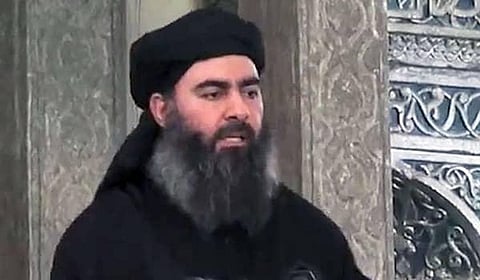
- Home
- न्यूजग्राम
- India
- World
- Politics
- Entertainment
- Culture
- Lifestyle
- Economy
- Sports
- Sp. Coverage
- Misc.
- NewsGram Exclusive
- Jobs / Internships

By NewsGram Staff Writer
According to reports from Radio Iran, the Islamic State chief has died following injuries from an air strike against an Iraqi target last month. The terrorist was responsible for the death of 215,000 people in Syria alone, while the situation created by his group is being seen as the worst military threat to the world after World War II.
Baghdadi stood in stark contrast to any other religious leader. Even amongst the extremists, he possessed a peculiar history and a flexible strategy which stood as the cornerstone of his ISIS vision.
Starting from 2010 onwards, Baghdadi captained the ship of Islamic extremism with utmost efficiency and ease. Within a short span of five years he managed to usurp large swathes of Iraq and parts of Syria under the violent umbrella of ISIS.
The man was listed as a Specially Designated Global Terrorist by the US State Department, with a bounty of $ 10 million, second to only the leader of al-Qaida, Ayman al-Zawahiri.
Baghdadi–A regular guy
Baghdadi had a normal upbringing which should have ideally led to a more nuanced understanding of religion. Here are a few facts, from his childhood to his youth:
According to contemporaries of Baghdadi, he was not a preacher, although he used to lead the prayers sometimes. This is against the current image of Baghdadi as a grand Imam by the ISIS.
Even at the time of war by the USA for the ouster of Saddam Hussein, Baghdadi is believed to have harbored no ill-feelings against the Americans.
What led to the transformation?
Like many leaders, the life of Baghdadi was also a witness to a couple of landmark, life-defining events. Here is a look at the rapid transformation of Baghdadi:
In 2004, Baghdadi had a bitter argument with an owner of a local mosque, who was also his landlord. The owner had asked Baghdadi to join the Islamic Party, a thought which was sacrilegious according to Baghdadi. Seeing political parties as opposing God, Baghdadi refused the proposal and was subsequently banished from his house and eventually from Tobschi, his resident town.
Although the banishment might have been a catalyst for Baghdadi's shift in allegiance to violent, radical Islam, it was a stint in an American prison which established Baghdadi as the jihadist that he was.
In 2004, American forces had arrested him near Fallujah, and later imprisoned him at the Camp Bucca detention centre as a ''civilian internee" for almost an year.
He is believed to have been radicalized by jihadists from al-Qaeda, the terror inflicting Islamic group that was organizing large scale suicide bombings in Iraq.
Baghdadi–the unlikely sly operator of ISIS
Baghdadi had an unusual, typical style of operating and presenting himself. It was to present the least level of personality– or a secret persona to the outside world and his coterie of followers. This was particularly attractive to the youth and gave him an aura of innocence, which further magnified his mass-appeal.
In fact, this was one of the main reasons he managed to befuddle the Americans and escape their net. After failing to recognize him as a dangerous individual, the US guards released him from prison when it shut in 2009.
After being handed down the mandate of ISIS, Baghdadi had brought unprecedented changes in the workings of the terror group.
With decentralization of the power structure, he had ensured that one man's death does not lead to the disruption of the organization.
He was more scheming and circumspect in his approach and was willing to abort missions if he felt the life of his men was at stake.
The ISIS leader had spelled a deep and ambitious plan for the organization. He planned to expand the caliphate continuously and even visualized to take over Rome.
With his shrewd, calculative mind, Baghdadi ensured that ISIS became deeply entrenched within the Iraqi population, incapable of being dislodged by local police forces.
Although cases of sexual violence abound against non-Muslim women in ISIS, a clever tactic of involving women was also propounded by Baghdadi.
By injecting Islamic extremism with doses of novel tactics and strategies, Baghdadi had indeed brought in a tectonic shift in the working of ISIS. He ensured that the terror outfit stays alive, functioning as a well-oiled group, long after he perished to jihad.
